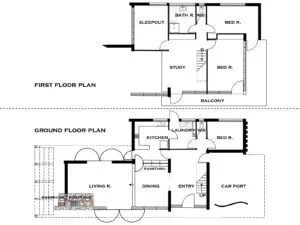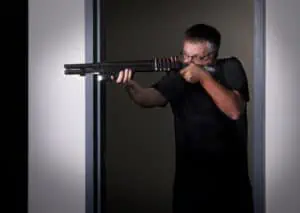Creating A Home Invasion Plan
We all like to think of our homes as a place of refuge from an increasingly troubled world. We tell ourselves “home, sweet home,” when we walk in the door of our abode, knowing that we’ve reached someplace where we can be truly safe. The thought that someone could shatter the peace and quiet of our homes with force scares us. If we’re not safe in our own homes, where can we be safe? The after effects of an armed home invasion are truly terrifying and potentially devastating, which is why having a home invasion plan in place and ready to go makes a lot of sense.
Let’s take a look at some numbers to get a better understanding of what the threat of home invasion really looks like. According to the FBI, there were 1,401,840 burglaries in the United States in 2017. 57.5% of those burglaries, or 806,058, involved forcible entry. As a comparison, the National Fire Protection Association reports that there were 367,500 household fires over the same time period. We have smoke detectors installed in our homes to warn us of a fire. There are plenty of public service announcements about what to do in case of a fire inside the home. Given the number of household fires versus forced entry crimes, it makes sense for us to spend some time creating a home invasion plan as well as a fire escape plan.
You Have A Fire Escape Plan. Why Not A Home Invasion Plan, Too?
A typical household fire plan will have instructions about how to safely exit the home in case of an uncontrollable fire. Fires affect the structure of a home, so it makes sense to leave while you still can. A home invasion, however, is different. The purpose of a forcible entry isn’t to destroy the structure. Rather, the goal of a home invasion is to obtain something from the structure such as cash, guns, pharmaceuticals or to commit harm on the occupants of the structure. Staying inside and protecting what’s near and dear to you makes the most sense in this case.
The idea of creating a home invasion plan stems from a legal concept called the “Castle Doctrine.” Simply put, the castle doctrine assumes that if someone breaks into your home, they are there for nefarious purposes, and you may defend your home as your result of their actions. The strength of the laws governing the castle doctrine varies from state to state, so please consult a lawyer (which I am not) and get actual legal advice about this if you want to know more about this idea.
The Castle Walls Have Been Breached. Now What?
For the purposes of this article, then, we’re going to assume that there is someone inside your home who used force to get in, and you have a reasonable fear that they intend to do you harm. Welcome to Worst Case Scenario Land, population: You. What should your home invasion plan look like if this happens to you and your loved ones?
First off, create a place of refuge inside your home, a safe room where everyone knows to go to in case of a home invasion. This room should have one entry point which has a securely fastened door that locks. A standard interior door probably isn’t going to be strong enough. A solid-core door that’s attached to the door frame with long wood screws is much better. This is your rally point in case the unthinkable happens. You practice your home fire escape plan so you’ll know what to do if a fire engulfs your home. In that same manner, you should practice your home invasion plan for the day when the unthinkable happens to those in your charge.
Safe In The Safe Room
Inside of your safe room should be the gear you need to stay safe until law enforcement arrives.
There should be a defensive firearm of some kind, with a decent amount of spare ammunition at the ready. How much ammunition will depend on the gun, but 2-3 full magazines for a pistol, a spare magazine for a rifle and a dozen or so shotgun shells should be enough.
Other gear to have in your safe room besides your gun is a flashlight, the brighter, the better. Getting the word out to law enforcement is easier if you have a cell phone handy, so keep one in your safe room. Any cell phone can be used to dial 911 whether it was a paid up service plan or not. Keep an older phone plugged into an outlet in your safe room, ready to use at a moment’s notice, and you’ll have a communications device that’s ready to go when it’s needed the most.
There is the possibility that you or a loved one may be injured in the process of defending your home. Having a comprehensive first aid in your safe room is a good idea. Make sure that it covers the basics of fixing up cuts and scrapes as well as being well-stocked to treat gunshot wounds and other trauma gear. Successfully defending your home is great, but if you stop the bad guy and take rounds in the process, or a loved one bleeds out after everything is over, it will put a damper on your enthusiasm about what just happened.
A Good Home Invasion Plan Begins With You
If you carry concealed on a regular basis, I recommend carrying a gun on you inside the home. This is in addition to the gun in your safe room. A defensive pistol on your person allows you to react almost instantly to a threat when it appears. Having a gun on you is the best option for when you’re outside the house. We carry a firearm on our person because we know that hoping we don’t get shot as we run back to our car for our gun is a bad idea. The same is true for a gun inside the house. If we can stop the threat before we need to retreat to a safe room, that’s a win for us.
Let’s say the worst has happened, and the bad guy is in your house. Should you move about the house, looking to engage him? Well, that depends. If all your loved ones are with you in your safe room, I don’t see a need to go looking for more trouble. If the bad guy is still out there are loved ones in your home who are not in your safe room, you’ll probably want to make sure they’re okay. This means you’ll need to carefully go through your home, clearing each room as you go. If this sounds less than optimal, you’re right, it is. However, having a loved one in danger is even more of a problem, so act accordingly.
Make A Plan And Act On It
Setting up a home invasion plan should be a priority for moving into a new home. A plan to move your loved ones to your safe room gives you a fighting chance against those who would do you harm. More important than any piece of gear, however, is the realization that bad things can happen to good people, even inside their homes. Plan accordingly




